Back to page 1
The Design
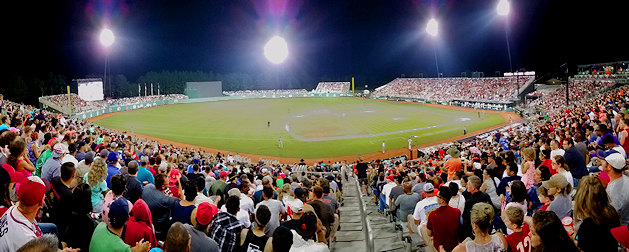 |
When you’re talking about a normal ballpark, you’re looking at permanent structures to house clubhouses, concessions, restrooms, the pressbox and, of course, the stands. That’s not the case at all with Fort Bragg Field.
“We relied on what we call ‘rental goods,'” said Bobby Sloan, Senior Associate at Populous, as he gave me a tour all the way around the park. “Everything you see except the (playing) field was rented.” This included the high-definition video screen (from a company called GoVision), the six light towers (from an intriguing company called Musco Lighting, who made news after providing illumination without charging for the rescue efforts at the Murrah Federal Building in Oklahoma City in 1995 and at World Trade Center in NYC in 2001), the generators, the tents that acted as buildings for the clubhouses and press, port-a-potties by the dozen, the bleachers, and the scaffolding to support everything.
The tents for the clubhouses, which even had batting tunnels, “are sizable structures,” said Barnes. “They aren’t just pop-up tents like you’d see in Home Depot. They are fully structured, wind-rated, engineered tent structures that allow the Braves and Marlins to have a full set-up and operation like a regular-season game.”
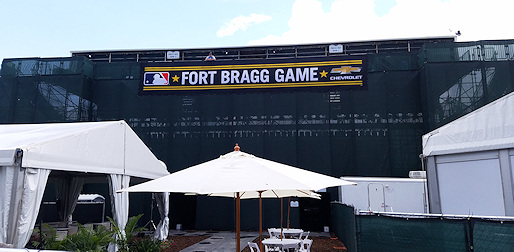 |
That led me to ask Barnes how the design of this temporary facility differed from a permanent ballpark. He surprised me with the answer. “It’s the same. Every aspect and detail is the same or similar … We have to provide the intention and detail of every aspect of a ballpark, whether it’s a temporary or permanent facility. All the design parameters are the same. All of the ratios and rules of thumb are utilized. So this is the same design process in that regard.”
Of course, you aren’t pouring concrete and putting thousands of tons of steel in place like you would in a stadium that is expected to last decades (this park did have thousands of metal supports making up the scaffolding though). The lack of concrete and steel kept the pricetag down somewhat, but it still cost a significant amount. In my conversation with Petitti, he wouldn’t divulge how much was spent on the construction, but ESPN let is slip that it was about $5 million.
“When you’ve got the right people and the right resources to bear, things can happen quickly and well,” Hill noted, adding with a chuckle, “I’ve joked that it’s nice to see what can happen when (projects) don’t have to go to the lowest bidder!”
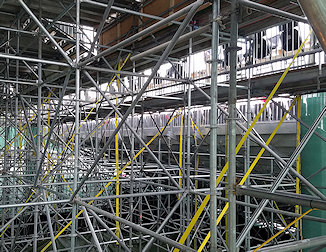  |
The pressbox definitely wasn’t a tent. It was a structure built on top of the most intricate set of scaffolding ever (above left). In front of a set of broadcast booths were two rows of countertops for the “working press.” I was assigned a spot on the front of those two rows. It was an excellent vantage point.
There were separate tent-like structures for first aid, player interviews, concessions, merchandise and a big, beautiful, air-conditioned media workroom (above right). I stress that these were all very sturdy tents.
There were four sets of port-a-potties behind the main seating bowl, and a string of them as far as the eye could see along the perimeter fence behind the berms (below left).
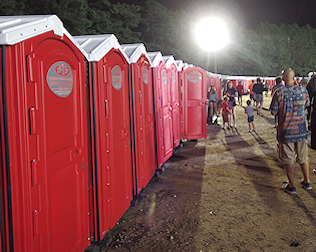  |
In the shot above on the right, you can see one of the six Musco Lighting trucks. Each carried a bank of lights on a telescoping support. “Those are in incredible demand,” Sloan remarked. “As soon as this game is over, they will all immediately head out of here to the next place where they’re booked.” The lighting of the field, by the way, was perfect. No doubt it met the requirements for a big-league ballpark.
The seating broke down this way: the majority of “seats” were in the two long stretches of bleachers that ran parallel to the foul lines. Each had seven seating sections. Between the elevated press area and the backstop were three sections of chair-back seats. These were for the guests of MLB and the Braves. There were more bleachers in fair territory beyond the outfield walls, near the foul poles. They had three sections each.
There were also two “berms,” in right center and left center. There was no grass on these. No, there was something akin to Astroturf on sloping metal plates being supported by the same kinds of scaffolding as for the bleachers (see shot below, which was taken well before the game, before the area was full). “OK, no it’s not a real berm,” laughed Sloan. “We’re seeing if we can fool people tonight.” Believe me, no one minded that their blankets weren’t spread out on real grass. With the heavy rain that afternoon, a real berm would’ve been a muddy mess.
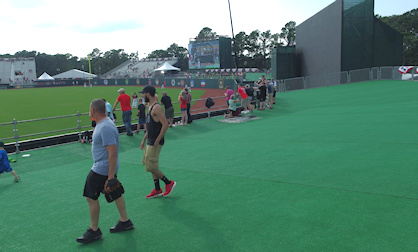 |
And speaking of the downpour just hours before gametime, one cannot overstate the stunning quality of the playing field and its drainage. Less than an hour after the deluge ended, the players were on the field warming up. There was no standing water anywhere on the playing surface.
Over and over again, you heard the name Murray Cook. He was lauded by Tony Clark, the Executive Director of the Players Association. He was praised by Commissioner Rob Manfred and MLB COO Petitti. He was even mentioned on the ESPN broadcast.
Cook is the president of the Sports Turf Division of a company called BrightView. Cook managed the playing fields for the 2000, 2004 and 2008 Summer Olympics. He’s worked on National Parks. And he’s MLB’s top consultant on playing fields, preparing the turf for the MLB contest in Cuba and the World Baseball Classic.
Manfred told ESPN’s audience that Cook basically lived at Fort Bragg for months, making the playing field perfect. And it was.
All for this one game, there was 8,000 tons of drainage gravel under 100,000 square feet of Bermudagrass sod (grown in North Carolina). The infield was created with 250 tons of clay. It took 400 tons of materials to make the warning tracks.
It drained like a dream.
Only one change is being made to the playing surface now that the Braves-Marlins game is behind us. “The infield will be converted from grass to an all-clay infield so we’ll be able to play softball and baseball on it,” said Hill.
The layout of the entire complex is masterful. Pulling this off successfully, with all of the satellite trucks, lighting towers, buses, generators, bleacher structures and tents, well, it boggles the mind. And it was successful.
“To put something like this together for just one game is unbelievable,” said Marlins manager Don Mattingly.
The Essentials
 |
Normally in this section, we look at the cost of attending a game and what the gameday experience is like. Well, a lot of that doesn’t apply here, so let’s see what the service men and women encountered when they saw the Braves play the Marlins on July 3rd.
Major League Baseball didn’t charge for the tickets, and I admire them for that. In fact, Fort Bragg and the Defense Department didn’t have to spend its own money to build the park or put the game on.
Back in June, Hill noted there was “much more demand than supply” when it came to seats for the game. The tickets were turned over to the commanders of each of the units at the installation in direct proportion to the unit’s percentage of overall service personnel there. The commanders then distributed the precious tickets to the service men and women and their families “using the process that they want to use.”
Any leftover seats were distributed in what Hill called “an online contest” to military retirees, Department of Defense civilians, National Guard members and Reservists in the area as well as any Active Duty service members who were not able to get tickets through their units. Did any tickets end up on StubHub or the like? “We have language in our ticket distribution (policy) forbidding that,” he said, adding that “negative action would be taken” against anyone selling their seats.
MLB handled souvenir sales at the game. There were two merchandise tents, near the two foul poles, and the lines were long throughout the evening. In addition to some Braves and Marlins t-shirts and caps, there were t-shirts ($29.99-37.99 for men, $29.99-34.99 for ladies), adjustable caps ($27.99) and even a lapel pin (yay, since I collect them) with the circular logo for the game. Yes, these are pretty high prices, but remember MLB didn’t have an entire season to move this merchandise. It was just one day.
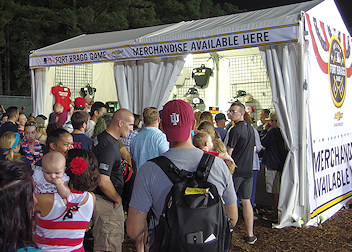  |
There were tents selling beer (16 oz. of Bud, Bud Light and Shock Top were all a reasonable $4). They were separate from other concessions. The non-beer food and beverage was handled by a firm called Carolls Corn Crib, out of Orlando. They also do the food at Fort Bragg’s huge 4th of July festivities every year. The fare was pretty simple: hamburger ($6); cheese steak sandwich ($8); burrito ($8); set of two tacos ($8); fries ($4); peanuts ($5); nachos ($8); soda ($4, and it was a Pepsi place, not Coke, even though it was a Braves home game!); and of course a hot dog ($5). Aaron Boone said during the ESPN broadcast that “the best hot dog I’ve had this year was here today.”
I met Joseph Lustman of Carolls. He coordinated the preparation and selling of the food, saying he’d “been here for a week getting everything ready.” He said that he’s the son of an Army man, so the importance of the event wasn’t lost on him. He called it “wonderful, historic,” adding that his “Mom’s 90th birthday is today and the party is in Chicago. Me, my wife, my son (and) my daughter are all here doing this. My siblings have been giving me grief for not being there.” Since his mother was married to a soldier, I think she understood why her relatives were at Fort Bragg that day.
MLB did a marvelous job of organizing the entire weekend. On the day before the game, 250 children of soldiers got to participate in a series of clinics and games put on by USA Baseball in conjunction with MLB’s PLAY BALL initiative. The day of the game, players and coaches from the two teams ate with the soldiers, toured the weaponry that the Special Operations forces use, tried their hand at packing parachutes for the paratroopers and, most importantly, visited wounded military members at the Womack Army Medical Center on the base.
Now let’s look at what the soldiers and their families saw while in their seats. Everything was indeed handled beautifully.
Although the jump by the Golden Knights Parachute team to deliver the ceremonial-first-pitch ball was scrapped due to the low ceiling of clouds, the pitch itself was awe-inspiring. Sergeant First Class Corey Calkins, a true war hero who helped save three injured Marines under hostile fire in Afghanistan (but whose humility had him decline interview requests), delivered the pitch. To call this Green Beret a “hero” is an enormous understatement. Read the account of his heroism from the Fayetteville Observer.
The National Anthem was a soaring, artistic triumph by Staff Sergeant Traci Gregg (see the caption under her photo below), as an enormous U.S. flag was unfolded in the outfield. Here’s a low-res clip on YouTube of her performance. At the conclusion of the song, four Apache helicopters from the 82nd Combat Aviation Brigade thundered over the stands to equally thunderous applause. Truly an unforgettable, emotional Anthem.
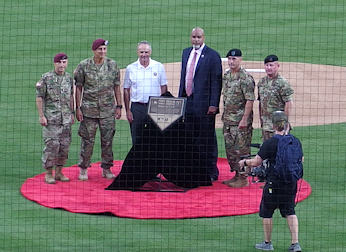  |
There were also two special presentations prior to the game. In one, Manfred and Clark presented a plaque officially naming the ballpark Fort Bragg Field (above left). Then the Players Association made a donation of $100,000 from the Players Trust to an organization called Our Military Kids that supports children of servicemen and women.
The Braves’ Matt Wisler made the first pitch of the game to the Marlins’ J.T. Realmundo (it was a ball). Miami’s Christian Yelich, whose 20-year-old brother Cameron serves in the U.S. Marine Corps, holds the distinction of having the first hit in the one-time-use ballpark. He went 3 for 5 that evening.
There was a moving ceremony at the end of the first inning, when MLB dedicated an empty chair to represent the 83,000 American servicemen and women killed since World War II whose remains have never been recovered (see photo above right). Representing the families of these Missing In Action heroes were relatives of Sergeant David Parke, who was killed in action in Korea in 1952.
ESPN Corporate Citizenship made a grant of $100,000 to the Boys & Girls Club at Fort Bragg to start a new Junior RBI program at the base. This will allow at least 300 children ages 5-12 to participate in organized baseball and softball there.
One of the biggest cheers of the evening came when the video board showed Country Music star Chris Stapleton, whom the PA announcer said was a guest of the Braves at the game. No doubt, there are a lot of Country fans in the Army.
A stirring rendition of God Bless America was performed by the 82nd Airborne Division All American Chorus during the 7th inning stretch.
The one-and-only game’s one-and-only home run occurred in the top of the 9th when Realmundo blasted a Tyrell Jenkins pitch over the center field wall.
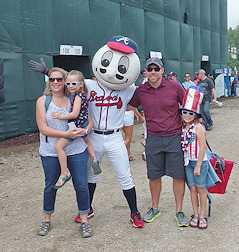 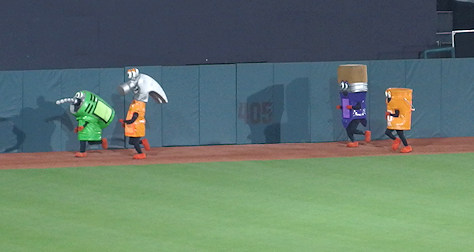 |
Since the game was originally scheduled to be a Braves home contest in Atlanta, every effort was made to have the feel of a game at Turner Field. The team’s mascot Homer was present (above left), as were the cute young ladies of the Tomahawk Team. The Home Depot Tool Race was run (above right). The tomahawk-chop chant could be heard throughout the game. You could hear a trumpet playing the familiar CHARGE melody when the Braves were batting. Organ music filled the park between innings, played “live” by Matthew Kaminski, the organist at Turner Field. Charlie Daniels’ The Devil Went Down to Georgia was played during the 7th inning stretch, and Ray Charles’ Georgia On My Mind blared through the PA system following the game. It helped that far more of the fans in attendance were rooting for the Braves anyway.
The only element that failed to make it like a game at Turner Field was that Coke wasn’t served at the concession stands. As Atlanta-area resident Graham Knight told me, “Nothing is more Atlantan than Coke!!” Coca-Cola, of course, has its headquarters in Atlanta.
And those fans holding tickets certainly made use of them, despite the weather. There were 12,500 seats in the ballpark, while the official attendance was announced as 12,582.
You can read my article for USA Today here. It and the accompanying photos describe just what a special day it was.
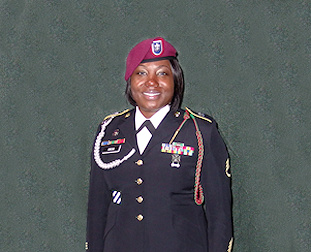 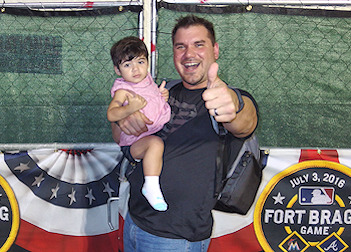 |
|
TWO OF AMERICA’S FINEST I was able to speak with a number of servicemen and women on the day of the game, and every one of them impressed me greatly. Two of them, though, absolutely blew me away. I caught up with Staff Sergeant Traci Gregg after she had done a magnificent job singing the National Anthem. When I asked her what it was like, the native of McBee, SC said, “It was an unreal moment. I was overjoyed to be able to sing the Anthem. As I was singing, I was standing there thinking that my dream has come true.” She added, “This is my third assignment at Fort Bragg. I’d been wondering why, why did I keep getting assigned here? But I knew in my heart that something good would come out of it, and it did. Getting to stand here in the land of the free, there is no greater honor. And to do this in this uniform, at my installation, it was such an honor. “Nothing I’ve ever experienced compares to this,” she continued. “It was like Beyoncé, who had a dream, and she made it come true. As a vocalist, I’ve always wanted to touch the world, to tell my story with my voice. Well, tonight it was like the windows of heaven opened up for me, and I was able to do that.” Equally impressive was Sergeant Daniel Fusco, who hails from Port St. Lucie, FL. As I was walking on the outer concourse, a baseball rolled by, probably an errant throw from a youngster. Fusco said to me, “That almost hit me. It reminds me of how they threw rocks at us when we were in Afghanistan. They kept throwing rocks and throwing rocks, until one time it turned out to be a grenade.” Fusco went on to tell me more about his nine-month deployment during “a horrific time in Afghanistan.” He then told me about his two-year-old daughter Brooklyn, whom he’s holding in the photo above. She suffers from a seizure condition known as anoxic brain injury. “When she was six weeks old, she had a massive seizure and was in a coma for a month. The doctors told us that she’d never be able to walk. My wife quit her job to take care of Brooklyn full time.” Then came the clincher to his story: “One of the most meaningful things ever done for an American soldier is this game. Even though I work 10 to 15 hours a day, on a sergeant’s salary, I never could’ve afforded these tickets (if they had charged for them). Being able to spend tonight here with my daughter, for free, means everything to me. Major League Baseball did this for us.” At the press briefing prior to the game, Commissioner Manfred revealed, “I’m always impressed by the quality of the people who serve our country.” Staff Sergeant Gregg and Sergeant Fusco are two of many, many examples of this. In my opinion, something is wrong with you if you aren’t proud of our servicemen and women. |
Summary
 |
Fort Bragg Field was truly a special place, and unless you were one of the 12,582 fans on hand (or a lucky member of the media like me), you’ll never get to see it. Take my word for it: the park was beautiful and more than served its one-game purpose. As Commissioner Manfred put it, the park was “really beyond what I expected.” Amen.
And it’s impossible to do justice to the atmosphere at the ballpark on July 3rd. The level of appreciation shown to the players for coming to Fort Bragg was obvious … but just as obvious was how, to a man, the players were overwhelmed with gratitude toward the soldiers. Veteran Braves catcher A.J. Pierzynski said that participating in the game and the events that led up to it “ranks right up there with anything I’ve ever done. (These soldiers) could lose their lives doing what they do, away from their families.” The Marlins’ Christian Yelich said, “This is a once in a lifetime opportunity to play a game on a military base (because) the people who serve our country are the best our society has to offer.” The Braves’ Jace Peterson remarked, “This is all pretty mind-blowing. It’s a really special day, a humbling experience. It is a special honor and privilege to be here.”
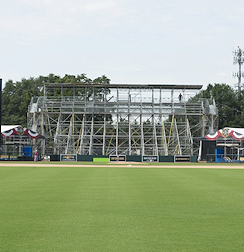  |
|
WHAT GOES UP … Within in a matter of days, all of the bleachers and seats had been carted away. On the left is the area behind home plate that used to hold the press box and the chair-back seats. On the right, workers are organizing the scaffolding materials to ship them back to where they came from. (Photos courtesy of Fort Bragg Public Affairs Office) |
The Fort Bragg personnel coordinating the event were equally appreciative — and excited. Christina Douglas, a civilian employee who has worked in military public affairs for the past 12 years, called Sunday’s game “the most meaningful event I’ve ever seen. Major League Baseball and the Players Association have gone above and beyond for our service members, their families and the whole Fort Bragg community.” Douglas, by the way, was an absolute delight to work with, in helping me with all of my research prior to the game, on the day of the game itself, and with follow-up items afterwards. She really exhibits the professionalism and service mentality at the installation.
I echo Jace Peterson’s remark: it was truly an honor and privilege getting to attend the only game at the once-in-a-lifetime ballpark.
Feel free to add your thoughts about Fort Bragg Field or this review below.
Joe,
A once-in-a-lifetime ballpark. A once-in-a-lifetime experience. You lived it! Thank you for taking us on another wonderful ballpark ride!
Alan Poff
BallparkBiz.com
And it’s gone, you named it the ballpark of the year and it no longer exists…….funny.
Thanks for commenting. In the press release, I admitted that it’s an unconventional choice as Ballpark of the Year, but Fort Bragg Field was unlike anything ever attempted. I loved the concept and I loved the motivation behind it (to show appreciation to our military). Tax-payer dollars weren’t spent constructing it, and the soldiers didn’t even have to pay for their tickets. I thought it was a fantastic gesture on the part of MLB and the Players Association.
Murray Cook is a well respected turf consultant. However, he did not design the playing field. The playing field’s success was a joint effort and designed by an engineering firm (FTE) out of Florida who has extensive MLB playing field design experience. It’s unfortunate when artistic and creative people who actually do the design and concepts, never get credit for the end product.
Jennifer, I certainly didn’t mean to slight anyone in my article about Fort Bragg Field. However, I was just going on the info given to me by MLB and the folks at Fort Bragg. In fact, Murray Cook and his company (BrightView) are mentioned prominently in the press notes and were discussed at length by MLB execs at press briefings. FTE wasn’t mentioned. To whatever extent they were involved in the playing field, though, let me just say they did outstanding work, because the end result was exceptional.